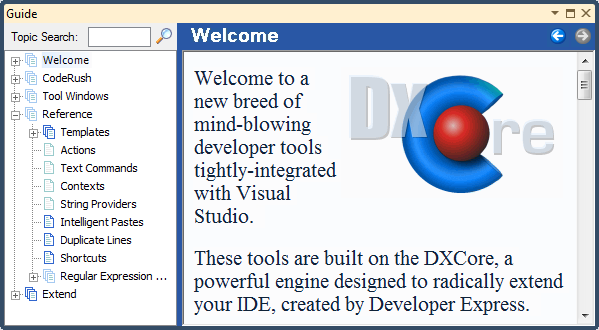The TextFields DXCore service provides access to the Text Fields engine. Text fields allow you to enter data and then press Num Enter or Enter to quickly move to the next text field. Text fields are highlighted in the editor and usually have a tool tip below describing the data expected.
Read more…
Starting with the next minor update v2011 vol2.8, the Unit Test Runner supports injection of environment variables for 3rd-party tools. Third-party tools may require providing the CodeRush Unit Test Runner with some environment variables for proper execution when launching the Test Runner process.
Read more…
IDE Tools User Guide supports static and dynamic content. The static text is stored inside the “*.htm” files, and the pictures are stored in the independent files in the appropriate format (gif, jpeg, png, etc). The static content can be manually edited right inside of the User Guide. There are also two DXCore controls useful for population dynamic content. These controls are the Tutorial Page Provider and Tutorial Content Provider. In this article, we’ll add some static content to the built-in CodeRush Documentation shown inside User Guide, and provide some dynamic content using the Tutorial Content Provider component.
Read more…
The Tutorial Content Provider DXCore component returns a section of an HTML code for display in the CodeRush User Guide. Many sections of the user guide are dynamically generated, so you can extend it with any content according to your preference. Here’s a preview of the User Guide:

Read more…
The Tutorial Page Provider DXCore component returns an HTML page, and registers it inside the topic tree of the DXCore User Guide. Many sections of the user guide are dynamically generated, so you can extend it with additional content according to your preference:

Read more…
A feature of CodeRush and/or CodeRush Xpress products) resides in DXCore plug-ins. A plug-in is special class that resides in an assembly that is loaded into the Visual Studio environment when DXCore starts-up.
While plug-ins implement the high level solutions you see, they don’t do all the work. Each plug-in references a namespace in the DXCore, which holds a powerful framework packed with low-level services and events.
Read more…
The DXCore has a mechanism for creating extensible plug-ins. Using the existing architecture gives some benefits:
- Child plug-ins that extend your plug-in are managed by our demand-loading architecture.
- Creating a child plug-in can be done in a component-based manner. That is, the user can drop your “extension” component on their plug-in designer surface to extend your plug-in. Using this architecture is not hard:
